Answered step by step
Verified Expert Solution
Question
1 Approved Answer
The system to be controlled is a mechanical mass-spring-damper system. The input is a force, u and the output is the displacement of the

The system to be controlled is a mechanical mass-spring-damper system. The input is a force, u and the output is the displacement of the first mass, y. The open-loop system is represented by the blocks connected with dampers only and no springs. The spring (connected to the first block) provides the feedback in the model. The damping factors are b and the spring constant is k. y u M M k TASKS (by hand): 1. Compute the open loop transfer function of the model. y is the output, and u is the input. 2. Compute the closed loop transfer function. Verify that the feedback function, H(s), is equal to k. TASKS (using MATLAB): Use the following data for the tasks: m = 1, b = 0.1, k = 0.5. Use 0.1 as the step size for all simulations. 1. Develop a Simulink model (using the differential equations) for the open loop system. Simulate it for a step input of 1 for 50s. Is the system stable? 2. Develop a Simulink model for the closed loop system. (Again, by using the differential equations and not the transfer function). Simulate it for 50s. Is the system stable? What is the approximate steady state error and peak overshoot? 3. Implement the PD controller with the closed loop model. Adjust the controller gains such that there is negligible overshoot, and a settling time of about 10s. Will you be able to remove the steady state error with this controller? If yes, how? If no, why? The system to be controlled is a mechanical mass-spring-damper system. The input is a force, u and the output is the displacement of the first mass, y. The open-loop system is represented by the blocks connected with dampers only and no springs. The spring (connected to the first block) provides the feedback in the model. The damping factors are b and the spring constant is k. y u M M k TASKS (by hand): 1. Compute the open loop transfer function of the model. y is the output, and u is the input. 2. Compute the closed loop transfer function. Verify that the feedback function, H(s), is equal to k. TASKS (using MATLAB): Use the following data for the tasks: m = 1, b =0.1, k = 0.5. Use 0.1 as the step size for all simulations. 1. Develop a Simulink model (using the differential equations) for the open loop system. Simulate it for a step input of 1 for 50s. Is the system stable? 2. Develop a Simulink model for the closed loop system. (Again, by using the differential equations and not the transfer function). Simulate it for 50s. Is the system stable? What is the approximate steady state error and peak overshoot? 3. Implement the PD controller with the closed loop model. Adjust the controller gains such that there is negligible overshoot, and a settling time of about 10s. Will you be able to remove the steady state error with this controller? If yes, how? If no, why?
Step by Step Solution
★★★★★
3.42 Rating (161 Votes )
There are 3 Steps involved in it
Step: 1
Task 1 Compute the open loop transfer function The open loop transfer function of the massspringdamper system is given by Gs us ys k m1s2 bs k where k ...
Get Instant Access to Expert-Tailored Solutions
See step-by-step solutions with expert insights and AI powered tools for academic success
Step: 2

Step: 3

Ace Your Homework with AI
Get the answers you need in no time with our AI-driven, step-by-step assistance
Get Started


